How we got here: A timeline of the shutdown
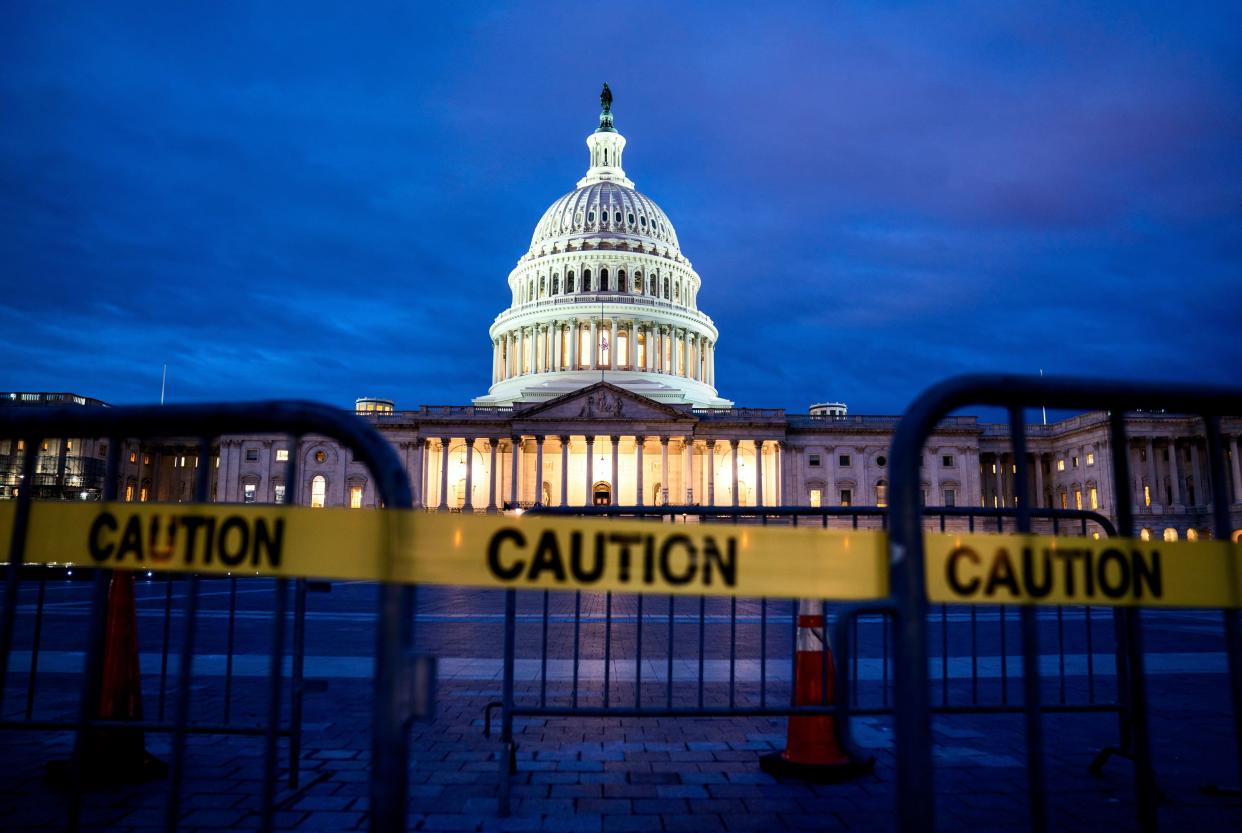
After 35 days, President Trump announced that the federal government shutdown — the longest in the nation’s history — would come to a temporary end. With the public taking Trump at his word that he would be “proud to shut down the government,” White House surrogates stumbling in their efforts to spin the shutdown’s effect on the American people and Republican senators beginning to defect to a Democratic bill in Thursday’s vote, Trump agreed to reopen the government without funding for his border wall.
The shutdown’s cause was Trump’s inability to secure funding for the wall that was a staple of his rallies during the 2016 campaign. Along the way there were complications, including his attempt to end President Barack Obama’s program of Deferred Action for Childhood Arrivals (DACA), which stayed deportation for undocumented immigrants who arrived as children, and attempts by some in Congress and the administration to limit legal immigration and grants of asylum.
With 800,000 federal workers finally set to be paid, here’s a timeline of how we got here.
June 16, 2015
“I will build a great wall ― and nobody builds walls better than me, believe me ―and I’ll build them very inexpensively,” said Trump while announcing the launch of his presidential campaign in New York. “I will build a great, great wall on our southern border, and I will make Mexico pay for that wall. Mark my words.”
Trump’s campaign website, in a now-deleted campaign promise, proposed that Mexico would pay for the wall, reading, “It's an easy decision for Mexico: make a one-time payment of $5-10 billion to ensure that $24 billion continues to flow into their country year after year.”
On Jan. 5, the New York Times reported the wall was conceived by campaign advisers as a way to keep Trump focused on immigration while campaigning instead of veering off topic.
“How do we get him to continue to talk about immigration?” Sam Nunberg, an early Trump adviser, told the Times. “We’re going to get him to talk about he’s going to build a wall.”
July 18, 2016
The Republican National Convention adopts the official platform for the 2016 convention nominating Donald Trump. It reads, “That is why we support building a wall along our southern border and protecting all ports of entry. The border wall must cover the entirety of the southern border and must be sufficient to stop both vehicular and pedestrian traffic.”
Nov. 8, 2016
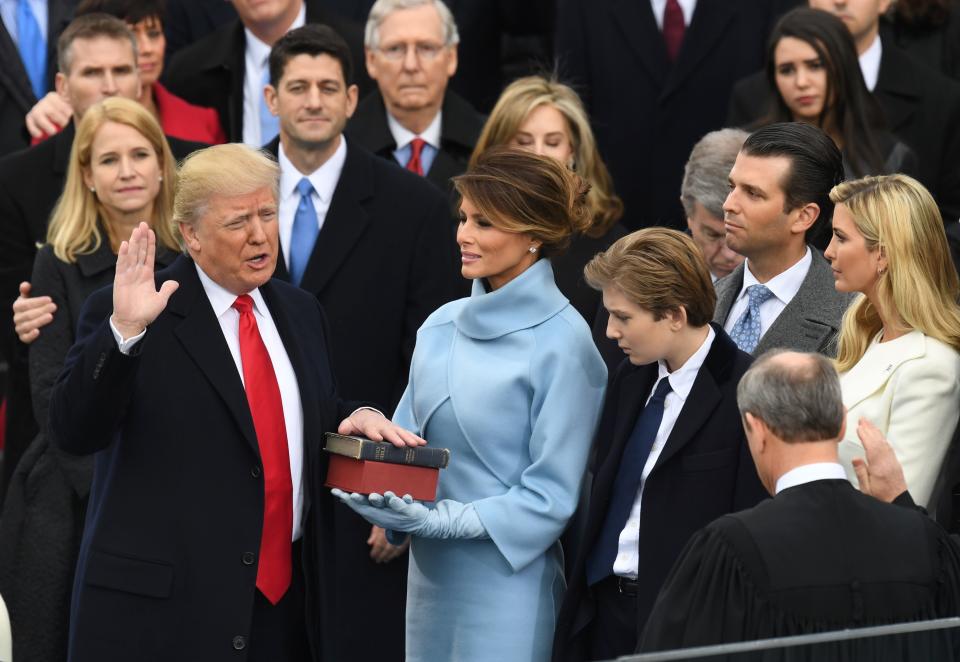
Trump wins the presidential election and Republicans maintain majorities in the U.S. Senate and House, giving them unified control of the federal government after the Jan. 20 inauguration.
Jan. 27, 2017
In a phone call with Mexican President Enrique Peña Nieto, Trump insists he has to keep up the pretense that Mexico will pay for the wall and asks Peña Nieto not to embarrass him by saying the opposite: “[T]he fact is we are both in a little bit of a political bind because I have to have Mexico pay for the wall – I have to. I have been talking about it for a two-year period. ... They are going to say, ‘who is going to pay for the wall, Mr. President?’ to both of us, and we should both say, ‘We will work it out.’”
Sept. 5, 2017
Trump announces he is ending DACA.
Obama issues a statement on Facebook, calling the decision "cruel" and "self-defeating, adding that “the action taken today isn't required legally. It's a political decision, and a moral question.”
Sept. 13, 2017
Democratic leaders Rep. Nancy Pelosi and Sen. Chuck Schumer attend a dinner meeting at the White House and state afterward that they had reached a deal with Trump that would provide a plan to replace DACA as well as providing funding for border security — although not a wall.
Sept. 14, 2017
Trump tweets that “No deal was made last night on DACA.”
Oct. 8, 2017
The White House sends a list of immigration demands to Congress, including removing protections for unaccompanied minor immigrants, increasing the authority of state and local police to investigate immigration status and curbing “chain migration” by limiting visas for spouses and family members of immigrants who come to the United States to work.
"The Administration can't be serious about compromise or helping the Dreamers if they begin with a list that is anathema to the Dreamers, to the immigrant community and to the vast majority of Americans," said Pelosi and Schumer in a joint statement. "The list includes the wall, which was explicitly ruled out of the negotiations. If the President was serious about protecting the Dreamers, his staff has not made a good faith effort to do so."
Oct. 25, 2017
Trump tells reporters on the White House lawn he’d be interested in doing a deal for DACA.
"I'd love to do a DACA deal,” said Trump, “but we have to get something very substantial for it – including the wall, including security, including a strong border.”
Jan. 9, 2018
In a bipartisan meeting at the White House, Trump seems to agree with the suggestion of Sen. Dianne Feinstein, D-Calif., to pass DACA before moving on to comprehensive immigration reform.
“We’re going to come out with DACA,” said Trump, “We’re going to do DACA, and then we can start immediately on the Phase 2, which would be comprehensive.”
“Would you be agreeable to that?” asked Feinstein.
“Yeah, I would,” said Trump. “I think a lot of people would like to see that, but we have to do DACA first.”
At this point Rep. Kevin McCarthy, R-Calif., reminded the president that the deal he was agreeing to was not the position of the Republican Party.
“You’ve got to be clear here,” said McCarthy. “What Sen. Feinstein is asking, we don’t want to be back here in two years later, you have to have security as the secretary would tell you.”
McCarthy, the Republican leader in the House, said Congress wouldn’t pass DACA without also addressing border security and chain migration.
"This should be a bill of love," Trump said. "Truly, it should be a bill of love, and we can do that."
Jan. 20, 2018
The government shuts down for three days as Senate Democrats insist that language to protect Dreamers be included in the spending deal. They eventually relent, agreeing to a short-term funding bill.
Schumer likens negotiating with Trump to negotiating with Jell-O.
Jan. 25, 2018
The White House releases a plan that includes a path toward citizenship for DACA recipients, $25 billion for the border wall and a gutting of the legal immigration system. Members of both parties urged Trump to drop the demands for legal immigration cuts while the right-wing website Breitbart referred to him as “Amnesty Don” for his plan to protect Dreamers.
Feb. 15, 2018
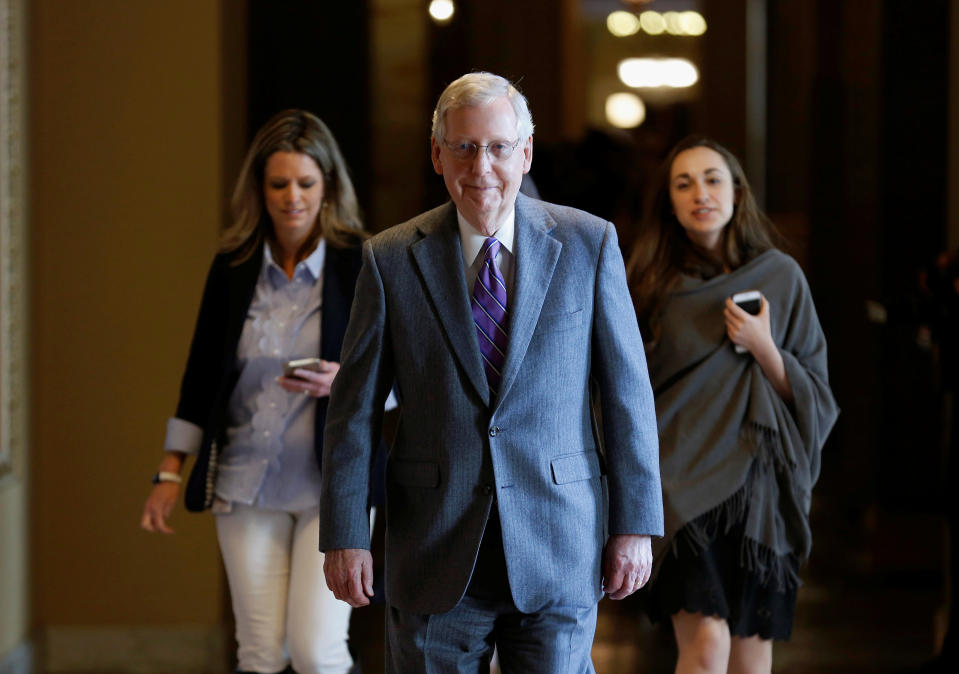
The Senate fails to find the 60 votes to move forward with any of four immigration-related bills. The bill with the proposals backed by the White House garnered just 39 votes. A measure that would have provided a pathway to citizenship for DACA recipients and $25 billion for general border security received 54 votes.
June 21, 2018
The House fails to pass a hardline immigration bill that would have severely cut legal immigration, by a final tally of 193 to 231, including 41 defecting Republicans in opposition. A moderate Republican plan to force a vote on a bill to protect Dreamers using a tactic known as a discharge petition fell two signatures short after pushback from House Speaker Paul Ryan.
June 27, 2018
House Republicans plan to vote on a new immigration deal and receive encouragement from Trump via an all-caps tweet: “HOUSE REPUBLICANS SHOULD PASS THE STRONG BUT FAIR IMMIGRATION BILL, KNOWN AS GOODLATTE II, IN THEIR AFTERNOON VOTE TODAY, EVEN THOUGH THE DEMS WON’T LET IT PASS IN THE SENATE. PASSAGE WILL SHOW THAT WE WANT STRONG BORDERS & SECURITY WHILE THE DEMS WANT OPEN BORDERS = CRIME. WIN!”
The measure loses by a vote of 121-301. Moderate Republicans blamed the ultra-conservative Freedom Caucus for undercutting weeks of negotiating.
Aug. 31, 2018
A federal judge declines to issue an order blocking DACA, ruling on a lawsuit brought by seven states, thus allowing the program to continue. The decision followed a January ruling that said the program should be kept running while it is being litigated, a February ruling blocking the administration from ending DACA, an April ruling that also went against the White House and an Aug. 3 ruling that the program should be restarted in full.
Nov. 8, 2018
A federal appeals court rules against the White House on DACA, stating it cannot immediately end the program.
Trump signs a proclamation banning migrants who enter the United States between official ports of entry from claiming asylum. On Nov. 20 a judge blocked the proclamation, allowing asylum seekers to enter between official ports, and on Dec. 7 a federal appeals court upheld that decision.
Dec. 11, 2018
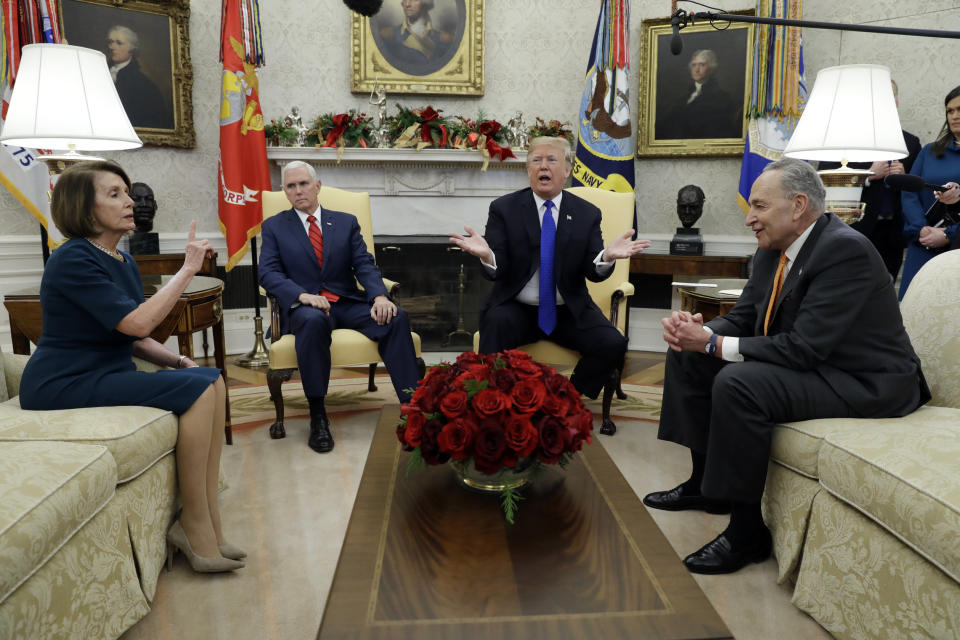
In a televised meeting with Pelosi and Schumer, Trump stated that he was comfortable shutting down the government for border security.
“I am proud to shut down the government for border security, Chuck,” said Trump. “Because the people of this country don’t want criminals and people that have lots of problems and drugs pouring into this country. So I will take the mantle. I will be the one to shut it down. I won’t blame you for it.”
Dec. 19, 2018
The Senate passes a spending bill that would keep the government open through Feb. 8 without providing funding for the wall, legislation the White House had not publicly endorsed. Conservative pundits Rush Limbaugh, Ann Coulter and Michelle Malkin all speak out against the lack of funding for the wall.
"Trump gets nothing and the Democrats get everything, including control of the House in a few short weeks,” said Limbaugh on his radio show.
Dec. 20, 2018
Trump tells lawmakers he will not sign the deal the Senate passed the day before. Speaker Ryan declines to bring the Senate bill up in the House, where it might have passed with a veto-proof supermajority.
"Any measure that funds the government has to include border security — not for political purposes, but for our country," said Trump.
Dec. 21, 2018
The House passes a stopgap funding bill that includes $5 billion for the wall. Following Democratic opposition in the Senate, the bill stalls there.
Dec. 22, 2018
As appropriations run out with no new spending authority, a partial government shutdown begins, affecting approximately 800,000 federal employees.
Jan. 8, 2019
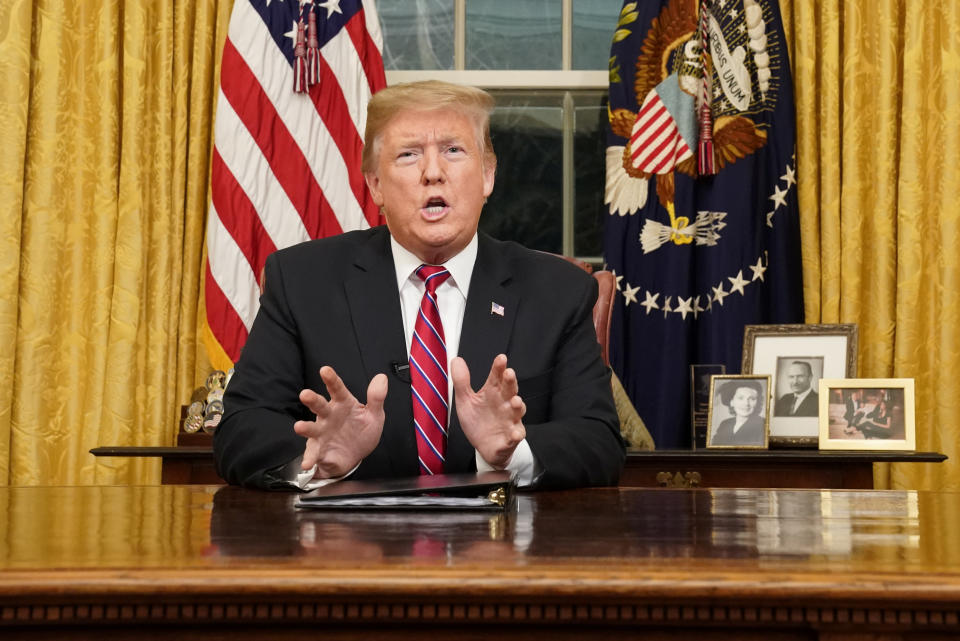
Trump gives a primetime address from the Oval Office demanding funding for a wall and calling the situation on the border a “crisis.” Pelosi and Schumer respond, saying they want to reopen the government but remain opposed to money for the wall.
Jan. 9, 2019
Pence says that DACA isn’t on the negotiating table until the ongoing lawsuit over it is decided by the Supreme Court.
Jan. 10, 2019
Trump visits the border in McAllen, Texas. Contradicting his months of campaign promises, he denies promising that the wall would be paid for by Mexico.
“When I said Mexico would pay for the wall in front of thousands and thousands of people, obviously I never said and never meant they’re going to write out a check,” he said. “Mexico will pay for the wall indirectly.”
Jan. 13, 2019
Contradicting Pence’s statement four days prior that DACA wasn’t on the table, Trump tweets: “Democrats are saying that DACA is not worth it and don’t want to include in talks. Many Hispanics will be coming over to the Republican side, watch!”
Jan. 19, 2019
Trump offers Democrats a deal of temporary protections for DACA and Temporary Protected Status (TPS) holders — refugees living in the United States who face persecution or other dangers in their home countries — in exchange for $5.7 billion for the construction of new physical barriers along the southern border. The bill also would make it more difficult for Central American minors to apply for asylum.
Immigration hawks on the right decried Trump’s proposal as “amnesty.” Pelosi called the deal “a nonstarter.” In a statement, Schumer said, “It was the president who singled-handedly took away DACA and TPS protections in the first place — offering some protections back in exchange for the wall is not a compromise but more hostage taking.”
Jan. 22, 2019
The Supreme Court declines to take action on the Trump administration’s DACA appeal, meaning the November ruling keeping the program in place stays in effect.
Jan. 24, 2019
The Senate votes on two bills to reopen the government, a short-term funding bill put forward by Democrats, without an appropriation for the wall, and the Trump plan. Both bills failed to get the requisite 60 votes, but the Democratic bill came closer, failing by 52-44 (including six Republicans who crossed the aisle to vote yes). The White House plan lost, 50-47. Two Republican senators voted against the Trump bill while Democrat Joe Manchin of West Virginia voted yes.
After the votes fell short, Trump offered a deal that provided a “prorated down payment” on the wall. Pelosi said she didn’t think it was a “reasonable agreement” and questioned what exactly the president meant. “I don’t know if he knows what he’s talking about,” she asked reporters. “Do you?”
Jan. 25, 2019
Trump announces a deal to open the government through Feb. 15, allowing federal employees to receive their backpay. The agreement contains no funding for the wall. He held open the possibility that the shutdown could resume or he could declare a national emergency to build the border wall without a congressional appropriation.



